AI Robots Are Entering the Public World—With Mixed Results
- Automate Asia Magazine

- May 26
- 3 min read
They’re terrible cocktail party guests but operators say the potential of what robots can do is growing

Robots are stepping out. Once relegated to factories and warehouses, next-generation robots are popping up in public spaces—from retail stores to museums—cleaning, cooking and even conversing with humans.
Improvements in “brainpower,” most notably the adoption of the technology behind ChatGPT, and a surge of investment are helping drive their public debut and 2025 could be a turning point in what robots can do.
Operators say they expect to deploy more public-facing robots. The robotics and drone sector in 2024 had attracted about $12.8 billion in venture-capital dollars by mid-December, up from $11.6 billion in all of 2023, according to analytics firm PitchBook. While operators are excited about new GenAI-powered capabilities, they are mindful that this next generation of robots won’t excel at every human interaction without some stumbles.
Make that many stumbles.
“Some things which are very easy for people are very hard for robots,” said David Pinn, chief executive of Brain Corp, which provides software for automated floor-cleaning and inventory management robots used at retailers like Sam’s Club.
Even something as simple as picking up an arbitrary object and moving it “is a really hard problem in the world of robotics,” he said.
Traditionally, robots rely on code that tells them how to execute functions or react to specific scenarios. Variability of what they could do was more or less limited to the specific actions they were trained on.
At health system Houston Methodist, Chief Innovation Officer Roberta Schwartz discovered that robots designed to carry out a number of tasks, from checking fire extinguishers to carrying towels, often bumped into objects and got easily confused by elevators.
Robots that will operate in human spaces will need better dexterity and the ability to circumvent obstacles—both areas that generative AI, the technology behind many of today’s chatbots, could help with.
“You can train the robot through massive data sets to be able to achieve this kind of dexterity, that until now has only been achievable by our own labor,” said Brain Corp’s Pinn.
Generative AI could give robots the ability to plan and replan their tasks if they encounter an obstacle, understand what certain objects are even if they’ve never seen them before, and, critically, take commands in human language, said Marc Segura, president of the robotics division at ABB, a Zurich-based automation provider.
Conversation is a big factor as robots move further into human spaces. Will Jackson, founder and CEO of robotics company Engineered Arts, believes that sectors like hospitality and entertainment are ripe for the introduction of robots that not only talk like humans but look like them as well.

“Your conversation, your interaction, gestures, impressions, should be so natural, so intuitive, so obvious, that you immerse in that and you forget entirely that you’re actually talking to a machine,” Jackson said.
Several AI models power the speech of his company’s robots at entertainment venue the Sphere in Las Vegas and at the Computer History Museum in Mountain View, Calif., where they provide information to visitors and also entertain them.
As Engineered Arts integrates more AI, the robots will become better, more natural conversationalists, Jackson said. For example, while they’re fairly good at conversing one-on-one, they’re not great at “cocktail party” scenarios involving a group of people.
When it makes its scheduled debut in February at founder Elizabeth Truong’s restaurant in Los Gatos, Calif., a machine made out of ABB components won’t hold a conversation, but it will certainly entertain. Truong said the robot will slice vegetables and assemble the various pieces of a hamburger in the open restaurant kitchen.
BurgerBots’ robot doesn’t yet have a generative AI component, but Truong said that it could be a big unlock for another reason as well: giving diners the option to shout out their orders rather than type them in at a kiosk.
In addition to pushing robots beyond factories and warehouses, GenAI is supercharging the robots within them.
Anthony Middleton, engineering design lead for warehouses at PepsiCo’s Europe division, said the company currently has about 30 automated guided vehicles, which follow fixed paths, and autonomous mobile robots, which move more freely, in Europe. That could increase 10-fold in the next five years, he said, as the unit looks to boost its budget to $50 million during that period, Middleton said.
A major impetus is financial savings from reduced head count, Middleton said, but there are also other benefits like better service levels and increased safety when work is being done by robots rather than humans.
Middleton believes that better, GenAI-powered systems for helping robots navigate around warehouses could help make 2025 a tipping point.
“We are about to see a huge boom,” he said.
Source: www.wsj.com





-01.jpg)


